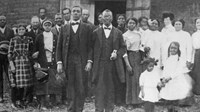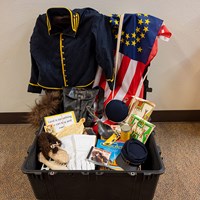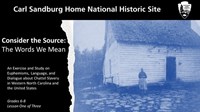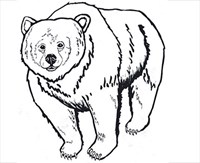- Lesson Plan (82)
- Field Trips (26)
- Distance Learning (24)
- Student Activities (16)
- Guest Speakers (10)
- Teacher Reference Materials (8)
- Other Education Materials (6)
- Primary Sources (4)
- Traveling Trunk (4)
- Media for Loan (1)
- Science Labs (1)
- Wright Brothers National Memorial (8)
- Craters Of The Moon National Monument & Preserve (7)
- Acadia National Park (6)
- Carl Sandburg Home National Historic Site (6)
- Homestead National Historical Park (6)
- Kennesaw Mountain National Battlefield Park (6)
- Charles Young Buffalo Soldiers National Monument (5)
- Eisenhower National Historic Site (5)
- Gateway Arch National Park (5)
- Show More ...
- Social Studies (114)
- Literacy and Language Arts (54)
- Science (46)
- Math (15)
Showing 163 results for black kettle ...
Winter Adaptations in the Black Hills
- Type: Student Activities ... Teacher Reference Materials ... Other Education Materials
- Grade Levels: Lower Elementary: Pre-Kindergarten through Second Grade
Black Hills Fire Ecology
Black Resistance through Election Day
Black Valor During the Spanish-American War
- Type: Guest Speakers
- Grade Levels: Adult Education

The Buffalo Soldiers were called to action during the Spanish-American War. At the start of the five-month war the men of these Buffalo Soldier units were labelled as heroes and praised for their sacrifices. However, at the war's end, the men's reputation had turned with negative press and gross insinuations. What changed? What happened that they were cut out of the picture with the Rough Riders?
Circles in the Snow
- Type: Student Activities
- Grade Levels: Upper Elementary: Third Grade through Fifth Grade

The goals of this activity include: - Students will be able to identify a tipi ring and explain what it means; tell the story of what happened to two Cheyenne women in Black Kettle's camp during the November 27, 1868 attack; and critically analyze and discuss why the soldier chose to disobey orders.
Black Homesteaders in Nebraska: Audacious Dreams (3rd - 5th)
- Type: Distance Learning
- Grade Levels: Upper Elementary: Third Grade through Fifth Grade

The Homestead Act of 1862 provided African Americans with the prospect of farm ownership. In Nebraska, Black homesteaders built successful farms from eastern tallgrass prairies to the arid Sandhills in the west and the intentional community of DeWitty, NE. Students will explore how Nebraska’s Black homesteaders persevered.
Black Homesteaders in Nebraska: Audacious Dreams (6th - 8th)
- Type: Distance Learning
- Grade Levels: Middle School: Sixth Grade through Eighth Grade

The Homestead Act of 1862 provided African Americans with the prospect of farm ownership. In Nebraska, Black homesteaders built successful farms from eastern tallgrass prairies to the arid Sandhills in the west and the intentional community of DeWitty, NE. Students will explore how Nebraska’s Black homesteaders persevered.
ʻĀhinahina Haleakalā
Black Homesteaders on the Great Plains: Life Liberty and the Pursuit of Happiness (Adult)
Breaking into the Army Nurse Corps: How Black Nurses Demanded to Serve
- Type: Guest Speakers
- Grade Levels: Adult Education

How did African American women break into the Army Nurse Corps? The nurses of the Army Nurse Corps were an essential part of the war effort. The African American nurses fought to serve their country and to be there for the Black soldiers they treated. Though hurdles were laid in their way, these women succeeded in enlisting in the Army. Many Black nurses went on to serve around the world and perform ground-breaking research.
Black Homesteaders on the Great Plains: Life Liberty and the Pursuit of Happiness (9th - 12th)
- Type: Distance Learning
- Grade Levels: High School: Ninth Grade through Twelfth Grade

The call of free land offered Black Americans a welcome reprieve from a cycle of poverty driven by sharecropping and racialized violence in the South. The Homestead Act of 1862 helped at least 3400 Black farmers build homes across the Great Plains. Homesteading attracted groundbreaking independent Black filmmaker Oscar Micheaux and agronomist and inventor George Washington Carver.
Black Homesteaders on the Great Plains: Life Liberty and the Pursuit of Happiness (6th - 8th)
- Type: Distance Learning
- Grade Levels: Middle School: Sixth Grade through Eighth Grade

The call of free land offered Black Americans a welcome reprieve from a cycle of poverty driven by sharecropping and racialized violence in the South. The Homestead Act of 1862 helped at least 3400 Black farmers build homes across the Great Plains. Homesteading attracted groundbreaking independent Black filmmaker Oscar Micheaux and agronomist and inventor George Washington Carver.
Washita Battlefield Traveling Trunk
- Type: Traveling Trunk
- Grade Levels: Upper Elementary: Third Grade through Fifth Grade

Learn about the role that Washita Battlefield played in the Plains Indian Wars as an expanding United States came into conflict with many Plains tribes such as the Cheyenne. The traveling trunk covers both sides of the battle, containing items for both the Cheyenne and 7th US Cavalry as well as six lesson plans to cover the Battle of the Washita. Lesson plans can be adapted to fit a wider range of grade levels.
George Washington Carver - The Artist: The Plant Doctor
Buffalo Soldiers: A Nickname
- Type: Guest Speakers
- Grade Levels: Adult Education

On July 28, 1866, Congress passed the Army Reorganization Act, which established six new all-Black regiments. As they were sent West, a nickname arose for these all-Black regiments. That nickname was “Buffalo Soldiers”. Though the nickname has unknown origins, it has grown to symbolize and honor those who served in the all-Black Army regiments.
Company 818 and Segregation in the Civilian Conservation Corps
Consider the Source: The Words We Mean: An Exercise and Study on Euphemisms, Language, and Dialogue about Chattel Slavery in Western North Carolina and the United States (Grades 6-8) Lesson 1 of 3 Carl Sandburg Home NHS
- Type: Lesson Plan
- Grade Levels: Middle School: Sixth Grade through Eighth Grade

This is the 1st of 3 lessons designed to contribute to middle school student's working knowledge of Black history in Western North Carolina. This lesson introduces students to the language of Black history and its relevance to their own dialogues and historical skills. With multiple interactive opportunities, and historical and artistic sources, students will develop language arts and critical thinking skills.










